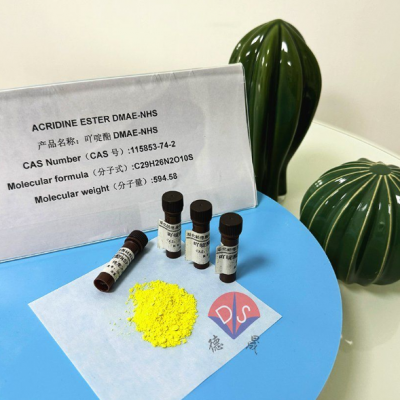Home > Products > Chemiluminescence reagent > Direct chemiluminescence of acridine ester DMAE-NHS 115853-74-2
Direct chemiluminescence of acridine ester DMAE-NHS 115853-74-2
50 - 99 Milligram
100 - 499 Milligram
≥500 Milligram
- 500 Milligram / Milligrams per Month
- Shanghai
- T/T PayPal Western Union
- 5 days
You May Like
-
Detailed introduction of luminescent reagent NSP-SA 211106-69-3
-
Precautions for using chemiluminescence reagent acridine salt NSP-SA-NHS 199293-83-9
-
Detailed Introduction to Acridoyl Hydrazide NSP-SA-ADH
-
What are the functions of luminescent reagent acridine ester ME-DMAE-NHS?
-
What factors determine the performance of biological buffer TRIS 77-86-1
-
Storage conditions for Tris HCl buffer 1185-53-1
Product Details
| Brand Name | Desheng | Place of Origin | China | |
| Model Number | DMAE-NHS | Purity | >98 | |
| CAS No. | 115853-74-2 | Classification | High Purity Reagents |
Product Description
Acridine ester DMAE-NHS is an important chemiluminescent reagent that can achieve conjugated labeling by reacting with amino groups in biomolecules, thus used for detecting the presence and quantitative analysis of biomolecules. At the same time, due to its direct luminescent properties, it is widely used in the field of biomedical research. Below, we will focus on analyzing the chemical properties, direct luminescence mechanism, and applications of acridine ester DMAE-NHS in biomedical research.
1、 Acridine ester DMAE-NHS direct luminescence
Acridine ester DMAE-NHS is a solid powder, typically yellow in color, that dissolves well in dry organic solvents such as dimethyl sulfoxide (DMSO) and dimethylformamide (DMF). It belongs to acridine ester compounds and has direct luminescence properties. Its direct luminescence mechanism involves the excitation of light, causing the acridine ester DMAE-NHS molecule to undergo a transition from the excited state to the ground state, resulting in luminescence. This direct luminescence property makes it an excellent chemiluminescence reagent suitable for analyzing the presence and content of biomolecules.
2、 Application of Acridine Ester DMAE-NHS in Biomedical Research
As a chemiluminescence reagent, it has a wide range of applications in biomedical research and can react with amino groups in biomolecules such as proteins, antibodies, and oligonucleotides to achieve conjugated labeling. By conjugated labeling with target biomolecules, chemiluminescence technology can be used for detection and quantitative analysis, thereby achieving research and analysis of biomolecules.
3、 Advantages and limitations of acridine ester DMAE-NHS
Acridine ester DMAE-NHS has many advantages as a chemiluminescence reagent, such as direct luminescence properties, high sensitivity, and wide detection range. In addition, it can react with amino groups in various biomolecules to achieve diverse labeling and detection. However, it also has some limitations, such as the possibility of background interference in some complex biological systems, which requires optimization and control based on specific experimental conditions.
Acridine ester DMAE-NHS, as an important chemiluminescence reagent, has direct luminescence properties and is suitable for labeling and detecting biomolecules in biomedical research. Its chemical properties are stable and easy to operate, providing powerful tools for biochemical experiments and biomedical research.
As a supplier of luminescent reagents, Desheng not only offers the product DMAE-NHS of acridine ester, but also has 5 different groups of acridine esters to choose from to meet different experimental conditions. Due to direct supply and no third-party sales, agents can be exempted from making price differences, helping customers save costs. If you are interested, please feel free to contact us at any time to make a purchase!
Contact Us

- Hubei New Desheng Material Technology Co., Ltd
- Contact nameDoris Yang Chat Now
Product Categories
| Additive for blood collection | Biological buffer | Chemiluminescence reagent | Chromogenic substrate |
New Products
-
99% of customers choose Bicine buffer manufacturer
-
Application of Biological Buffer CAPS 1135-40-6 in Diagnostic Kit
-
Why choose MOPS buffer produced and developed by Desheng?
-
High quality supply channel for biological buffer TAPS 29915-38-6
-
The buffering range of GOOD'S buffer EPPS 16052-06-5
-
Introduction to the use of biological buffer MOPSO buffer (CAS number 68399-77-9)
-
HEPES buffer for cell culture 7365-45-9
-
Precautions for using PIPES buffer solution
-
Introduction to the use of biological buffer BES CAS number 10191-18-1
-
The use of 3- [N, N-di (hydroxyethyl) amino] -2-hydroxypropanesulfonic acid DIPSO 68399-80-4
-
Exploring the synthesis method of the biological buffering agent sodium 2-cyclohexylamineethanesulfonate (CHES Na)
-
Low interference, high buffering efficiency: the key role of CHES 103-47-9 in molecular biology
-
Introduction to Biological Buffer CAPSO 73463-39-5
-
Introduction to Piperazine Buffer POPSO (CAS No. 68189-43-5)
-
Preparation and advantages of Tris acetate TAE as a biological buffer
-
Application of TAPSO 68399-81-5 Biological Buffer in DNA/RNA Extraction
-
Basic information of biological buffer N - (2-acetamido) -2-aminoethanesulfonic acid (ACES)
-
The pH range of N - (2-acetamido) -2-iminodiacetic acid (ADA) buffer
-
HEPBS biological buffer is a powerful assistant in cell culture and cosmetics manufacturing
-
You can't help but know about the applications of CHAPS buffer
-
Introduction and Application of Biological Buffer BIS Tris Propane 64431-96-5
-
Biological buffer piperazine-1,4-diethylsulfonic acid monosodium salt PIPES-NA basic information
-
Exploration of Buffer Performance and Stability of PIPES-K2 108321-27-3
-
2- (N-morpholine) ethanesulfonic acid monohydrate MES monohydrate
Popular Searches
Recommended Products
- The labeling principle and application of acridine hydrazide NSP-SA-ADH
- Stability and precautions of acridine ester (NSP-SA-NHS)
- Detailed introduction of luminescent reagent NSP-SA 211106-69-3
- Direct chemiluminescence of acridine ester DMAE-NHS 115853-74-2
- Luminescence analysis of high-purity acridine ester NSP-DMAE-NHS194357-64-7
- Isoluminol reagent for chemiluminescence
- Introduction and Precautions of Luminol Monosodium Salt 20666-12-0
- Analysis of Luminol 521-31-3 Chemiluminescence Characteristics
- Performance characteristics and usage instructions of color developing substrate DA67 115871-18-6
- Advantages and characteristics of the chromogenic substrate DA64 (115871-19-7)
- The role of chromogenic substrate TODB 127544-88-1 in triglyceride detection
- Application of MAOS 82692-97-5 in In Vitro Diagnostic Kit
Find Similar Products By Category
- Chemicals > Chemical Reagent
- Please Enter your Email Address
- Please enter the content for your inquiry.
We will find the most reliable suppliers for you according to your description.
Send Now-
 Doris Yang
Welcome to my shop, I'm glad to serve you. Please feel free to send me any questions you may have.
Doris Yang
Welcome to my shop, I'm glad to serve you. Please feel free to send me any questions you may have.
Your message has exceeded the limit.
- Contact supplier for lowest price
- Customized Request
- Request Sample
- Request Free Catalogs
Your message has exceeded the limit.
-
Purchase Quantity
-
*Sourcing Details
Your inquiry content must be between 10 to 5000 characters.
-
*Email
Please enter Your valid email address.
-
Mobile







